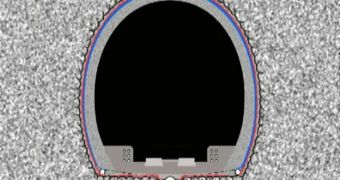As the world celebrates the opening of the Gotthard base tunnel through the Alps, engineers and researchers at Empa are proud to have participated in the design by solving a monumental problem – how to keep the construction dry for an entire century.
Gotthard is now officially the longest rail tunnel in the world, and it was inaugurated on October 15. The project calls for two individual tunnels to be drilled through the Alps, but the eastern one was already completed.
Another 7 years will most likely pass before the tunnels are opened for traffic, but nonetheless the achievement made here in remarkable.
The engineering challenges associated with drilling this massive construction were enormous. The base tunnel had to be drilled through a mantel of rock that was up to 2,500 meters thick.
One of the primary challenges was devising a way of preventing the massive pressure, rock temperature and groundwater seepage from destroying the tunnel, and also the railway equipment within.
At the very core of the mountain, rock temperatures can reach as much as 45 degrees Celsius, experts say, and so Empa engineers had the task of insulating the construction in protective materials.
The sealing and drainage system (SDS) therefore had to be built using the most advanced synthetic materials available today, and based on state-of-the-art construction technologies.
Even if the materials from which the tunnel is made are guaranteed to have a life span of about 100 years, there is no telling how reliable a 57-kilometer (35.4-mile) structure is.
When deciding on which materials to use for the construction effort, Empa experts turned to simulation chambers in order to test how various SDS would react to a wide variety of adverse conditions.
Some of the tests involved exposing the synthetic materials to the attack of both aerobic and anaerobic microorganisms, in oxygen-rich, acid, or alkaline environments, at temperatures of up to 70°Celsius.
In addition to contributing to the development of advanced SDS, Empa expertise was also used in other sectors of the construction site, such as for example in improving welding technologies.
Tunnel workers were also trained on how to join together the waterproof membranes that sealed the tunnel by using Velcro-like hooks and loop fasteners,rather than fixed washers, AlphaGalileo reports.
Engineers at Empa also used their impressive knowledge to design new catalytic filters for diesel engines, so that machines operating in the tunnels would not release dangerous levels of greenhouse gases.

 14 DAY TRIAL //
14 DAY TRIAL //